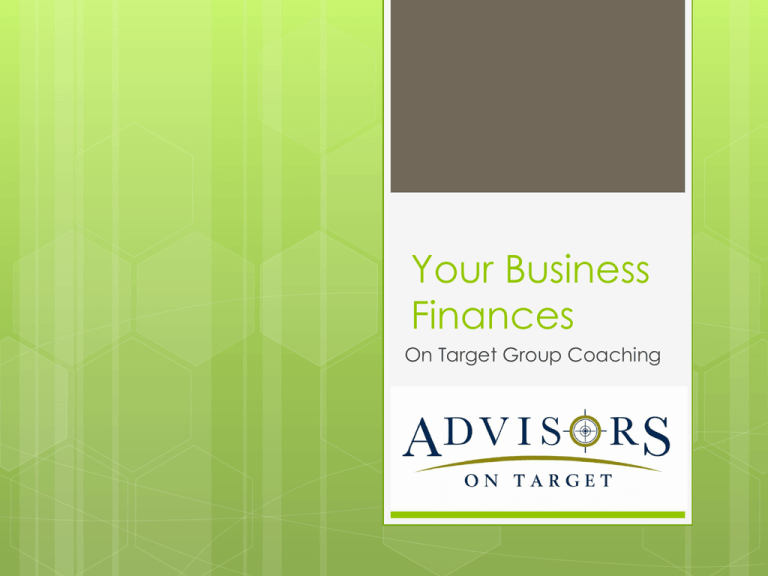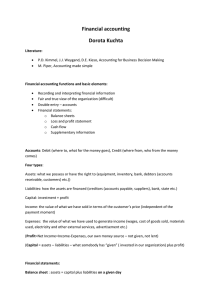Group-Coaching-Financial-Management
advertisement

Your Business Finances On Target Group Coaching Effective Financial Management 3 Financial Indicators Profits, Cash Flow, ROI Cost Behavior Profit Improvement Planning More Key Performance Indicators Liquidity, Solvency, Collections, Breakeven Creating a Budget/Profit Plan 3 Best Practices: Finance Accounting system is fully & accurately functioning Controls are in place to ensure accuracy A Realistic Workable Profit Plan (aka Budget) is in place Financial Monitoring is being used effectively as a business tool Key Metrics are being used to keep your finger on the financial pulse of your business Owner reviews Financial Data and Metrics at least monthly An adequate credit line is in place Company is profitable, solvent and able to finance its growth and reward stakeholders 4 Sound Financial Management is critical if you wish to: Put together a solid business plan Be in the best position to obtain financing Grow a sustainable business Create a valuable company that you can later sell or otherwise provide for your exit from the business Effective Financial Management Key Financial Data For Business Survival 3 Key Financial Indicators Of Your Business’ State Of Health Business is about making money To do this, it must simultaneously increase three things: Net profit margin – Operating profit margin Cash flow Return on investment (ROI) Indicator 1: Profit Margins Gross Profit = What’s left over after you deduct direct job costs from the revenue your business generates Gross Profit = Total Income minus Direct Expenses to Produce work Indicator of the productivity of your production people Indicator of the accuracy of your estimating and selling Net Profit = What’s left over after you deduct ALL expenses from the revenue your business generates Net Profit = Total Income minus Total Expenses THE bottom line in your business Indicator of the overall management of the business How To Calculate Profit Margins Gross Profit Margin (GP%) is profit derived from work produced divided by Gross Revenue Gross Profit Margin = (Gross Profit/Revenue)% Net Profit Margin (NP%) is after-tax net profit divided by Gross Revenue Net Profit Margin = (Net Profit/Revenue)% Improve The Gross Profit Margin by working on the drivers: Production / service delivery processes Material Costs Labor Costs Customer relations Team Skills and Development Pricing & Estimating Selling Skills Improve the Net Profit Margin by managing: Administrative Variable operating processes Costs Overhead Costs Customer relations Administrative Team Skills and Development Marketing Activities and Costs BEST PRACTICE GUIDE : Gross Profit % Gross Profit Margin = (Gross Profit/Revenue)% Higher is better – obviously Industry averages are different for different industries Set a target based on your budget BEST PRACTICE GUIDE : Net Operating Profit %** Net Operating Profit Margin = (Net Operating Profit/Revenue)% Higher is better 15% is goal (25% BEFORE Owner’s Compensation) 5% is industry average* *Residential and Commercial Contractors under $10MM ** There is a distinction between Net Profit and Net Operating Profit, which is Profit before taxes, and “other” income & expenses not related to operations of the business including financing costs (interest expense) The three questions of measurement Is it Accurate? Is it Acceptable Is it Sustainable? What Does The Cash Flow Cycle Mean To Your Business Operations? There will be occasions when money is flowing out faster than it is flowing in Virtually every business experiences times when there is a cash flow gap Managing cash flow so as to avoid any critical situation due to lack of cash when it is needed is a major responsibility of a business owner Cash Flow – More Than Just Profit Businesses can make a profit but have negative cash flow Failing businesses can have positive cash flow, possibly due to large asset sales or collections from past sales Business start-ups require large cash outlays to build the asset base = cash flow risk Cash flow Over The Longer Term Over the longer term, you have to manage your cash flow to fund your business growth You can grow your business in the short term by ‘borrowing’ credit through late payment of suppliers Eventually, however, everything evens out and such strategies are not sustainable With that in mind, projected growth should be managed within known cash flow constraints…and if external funds are required, this needs planning in advance Improve Cash Flow Shorten the Cash Flow Cycle Understand the difference between Cash Flow and Profit Plan in advance for business growth and/or downturns BEST PRACTICE GUIDE : Cash Flow Prepare a Cash Flow Projection Manage Your Spending on a monthly, if not weekly basis Invoice Promptly Develop a systematized approach to receivables and collections Obtain a line of credit Indicator 3: Return On Investment Return On Investment is net profit expressed as a percentage of the value of the total assets you have tied up in the business ROI = (Net Profit/Total Assets)% ROI is a profitability ratio – it is the true measure of the financial productivity of a business BEST PRACTICE GUIDE : ROI Return on Investment = (Net Profit/Total Assets)% Higher is better Should be at least 10% 25% or higher is a goal 21 Characteristics of Financial Health High tangible net worth (equity) Consistent profitability High cash flow from operations Cash balances representing 30-45 days of operating expenses AR representing less than 30 days sales A ratio of current assets to current liabilities (“current ratio”) in excess of 3:1 A high level of working capital A ratio of liabilities to assets of 1.0 or less (debt ratio) 22 How do we find out where we stand? Starts with Financial Statements: Profit & Loss Statement (Income Statement) Balance Sheet 23 Regarding Your Financial Statements… Accuracy is Essential GIGO Hire Kerry to help you shape up your books Accrual vs. Cash Basis Accrual Basis – Day to Day operations Enter Invoices and Bills as they are incurred – not as they are paid Cash Basis – Paying Tax Enter data on Accrual Basis/Click of a button will show reports in either format (in QuickBooks) 24 Chart of Accounts Tips Good Structure Sufficient detail to analyze data Use sub accounts where more detail is needed Consider using classes if appropriate Group Expense accounts appropriately All direct costs in COGS Non Operational Income and Expenses in “Other Income & Expense” section Group Balance Sheet Liabilities appropriately Loans that will not be repaid this year in Long Term Liability section Profit and Loss Statement Income Direct Costs (Cost of Goods Sold) Gross Profit Variable Expenses Overhead Expenses Net Operating Profit Other Income & Expenses Net Profit 25 26 Profit and Loss Statement Balance Sheet Description Cash Checking, Savings, Petty Cash Accounts Receivable Amounts Due from Customers Other Current Assets Prepaid Expenses, Amounts due from others Total Current Assets Fixed Assets Equipment, Vehicles, Property, Depreciation Other Assets Startup expenses, Goodwill from purchase, Company deposits, Long term loans made to others Total Assets Accounts Payable Amounts owed to Vendors Credit Cards Other Current Liabilities Payroll Taxes Payable, Customer Deposits, Short Term Lines of Credit Total Current Liabilities Long Term Liabilities Loans, Lines of Credit that will not be paid off in one year Equity Contributions, withdrawals, Retained Earnings, Net Income 27 Total Liabilities & Equity Must equal Total Assets to Balance 28 Balance Sheet Key Performance Indicators Factors that indicate the current and future performance of a business in areas that are critical to the company's success. Financial KPIs Revenue to Budget Gross Profit Net Profit Break Even Sales Liquidity - Current Ratio Solvency - Debt Ratio Collections (Days Sales Outstanding) BEST PRACTICE GUIDE : Gross Profit % Gross Profit Margin = (Gross Profit/Revenue)% Higher is better Industry Averages Differ Set a budget target to measure 31 BEST PRACTICE GUIDE : Net Operating Profit %** Net Operating Profit Margin = (Net Operating Profit/Revenue)% Higher is better 15% is a goal to shoot for (25% BEFORE Owner’s Compensation) ** There is a distinction between Net Profit and Net Operating Profit, which is Profit before taxes, and “other” income & expenses not related to operations of the business 32 BEST PRACTICE GUIDE : Liquidity Ratios Current Ratio = Current Assets Current Liabilities Should be a minimum of 1.5 or higher (3.0 or greater is better) Quick Ratio = Should be at least 1.0 Higher is better for both Cash + Equivalents Current Liabilities BEST PRACTICE GUIDE : Debt Ratios Debt Ratio = Total Liabilities Total Assets Should be less than 1.0 Debt to Equity Ratio = Long Term Debt Stockholder’s Equity Should be less than 1.5 or 150% BEST PRACTICE GUIDE : Days Sales Outstanding (Collections) Days Sales Outstanding = Accounts Receivable x 365 Annual Revenue (previous 12 months rolling revenue) Should be 30 days or less BEST PRACTICE GUIDE : Cash in Bank – Ideal Cash in Bank = Overhead Expenses* (next month) Gross Profit Margin Plus: Fixed expenses for months 2 & 3 Or – just think 3 months fixed expenses for a quicker calculation *Include Variable Costs and Overhead Costs 37 BEST PRACTICE GUIDE : Cash in Bank – Ideal Cash in Bank = Overhead Expenses* (next month)/Gross Profit % Plus: Fixed expenses for months 2 & 3 Or – just think 3 months fixed expenses for a quicker calculation *Include Variable Costs and Overhead Costs 38 BEST PRACTICE GUIDE : ROI • • • Return on Investment = (Net Profit/Total Assets)% Higher is better Should be at least 10% 25% or higher is a goal Implementation Steps Review your own financial statements and chart of accounts Ask me to review if you would like my perspective If you need help with your QuickBooks, hire Kerry Next Month: We’ll talk about Profit Planning and creating a budget Start thinking about your financial goals for 2013


